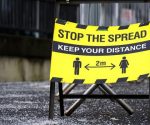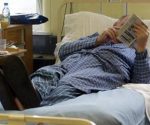The Covid-19 science problem; Part Two: obesity theory won’t provide a solution no matter how hard it’s pushed
At the crux of a new development in the understanding of Covid-19 is something called fibrosis (assuming that none of us have been familiar with the term). Essentially, this is a fault with the healing of wounds to organs. To speak technically about it, it is the expansion of extracellular material – and if this conveys to the reader an impression of abnormal growth, then the technical expression is also suitably descriptive too.
Fibrosis is caused in the following way. There are cells called myofibroblasts which perform the healing. When the curing is complete, extraneous myofibroblasts are supposed to be discarded in a process called apoptosis. When this doesn’t happen, in what is a failure of the function, there is a persistence of myofibroblasts – or fibrosis.
A particular medical supposition holds that fat cells drive the production of myofibroblasts. Following from this, it is thought that before a person who is particularly susceptible to Covid-19 comes down with the disease, he would have suffered pulmonary fibrosis, or persistence of myofibroblasts at the lung. So, this supposedly provides an explanation for why Covid-19 sufferers have been found also to experience hypoxemia, or low blood oxygen levels.
This is only one component of a set of two features for the theory of obesity at the root of Covid-19. In the other element, it is thought that fat cells, or adipocytes, present large amounts of ACE2 – meaning the protein angiotensin-converting enzyme 2 (ACE2) occurs as complex with the cell. ACE2, of course, has already been well established as being crucial to the Covid-19 account because of infection caused by SARS-COV binding to it. In this theory of a cause involving ACE2, it is thought that the infection is rooted in binding that takes places at fat cells. We should notice (and there will be further discussion of this) that is the reporting of this theory in the Daily Mail, it is somewhat left up to the reader to make a connection between SARS-COV to ACE2 binding at fat cells, and an infection at the lung, which is in fact the ailment that leads to the Covid-19 pneumonia. However, a big clue for any reader of the article should be how there is an admission that the “evidence isn’t concrete”.
In Part One of this series, it was stated that the mechanics of the disease had, mainly, thus far thought to have been the following (and please note, the revisit of the cause of ACE2 proliferation or imbalance will now happen in a later part of this series):
SARS coronavirus would bind with ACE2 receptors at the lungs, and in doing so create a corruption of matter that would lead to infection, to wit: the pneumonia…
It later emerged that SARS-COV-ACE2 binding may be the cause of the low blood oxygen levels that was observed in Covid-19 patients; it was thought that the lung damage was restricting the transfer of oxygen into the blood. Alternatively, the SARS-COV was affecting the levels of hemoglobin.
So, quite clearly, on the face of it – if we get to the point – the new obesity theory seeks to provide alternative explanation for both the aspects detailed in the quote above. It fully blames obesity for Covid-19, and seeks to explain, or at least imply for the sake of creating an impression, the mechanics of the illness.
Moreover, an obesity solution would make, what was called in the previous part of this series, the hearsay version of Covid-19 more compatible with the evidential one because it would mean of the three consistencies in all cases of “hearsay Covid-19” (a pre-existing illness, a diagnosis of infection with SARS-COV-2, and obesity in the patient), it could be said that it was the pre-existing illness that was irrelevant, with the pertinent part being the combination of obesity and the SARS-COV-2.
However, the obesity theory is problematic, not least because it needs to make sense of ACE2 on fat cells causing lung infection. First of all, as a benchmark, and from a casual search into the subject, one finds that an abnormality (e.g. inflammation associated with tobacco smoking) with “adipose tissue”, or fat, and its relation to pulmonary disease isn’t a thing clearly understood. Secondly, there is a fact raised in the Daily Mail report by “Ian Hall, professor of molecular medicine, University of Nottingham” which he might have intended as being one that disqualified the theory. He pointed out that “the virus enters through the respiratory tract, so it is the level of expression of ACE2 in the respiratory tract which is likely to be most important in early stages of infection.” The author feels this rather misses the point that it is SARS-COV to ACE2 binding at cells at the lung that causes the killing condition. Indeed, the knowledge base needs reminding that SARS-COV to ACE2 binding on lung tissue has been known about for nearly two decades.
Perhaps the big problem for the obesity theory is that the evidence perhaps just doesn’t bear it out; indeed, declaring it non-concrete is half way to this position. If one looks at the latest Intensive Care National Audit & Research Centre (ICNARC) audit which gives details of those who died and were discharged from critical care beds, one can easily see disproving information. The audit report pools Body Mass Index (BMI) of the patients into four categories: less than 25, 25 to less than 30, 30 to less than 40, and 40 plus. In all of these categories, more patients survive than die. Moreover, there is a greater percentage gap between those who survive and die in the two highest categories than in the two lower ones. In other words, the percentage of patients surviving increases in the two higher BMI categories.
The data is not there to confirm it, but it might be supposed that the low BMI might belong to the patients who are 60 years old and over – those who are more likely to die perhaps because they are frail – and this might be skewing the picture. However, in that case, one could say that what the figures are in fact showing is that high BMI merely contributes to a weaker immune system in younger people, and being older contributes to a weaker immune system in the aged – and so in fact what one would be seeing is that obesity is just a contributory factor in a whole other issue.
But in actual fact, there is an explanation for SARS-COV to ACE2 binding at the lung where obesity is a central issue, and this is the medication given to people supposedly suffering from hypertension, a condition that is reflexively closely associated with being overweight (see here – but, by necessity, there will be more to come on this topic). Ironically, it is also a prescription drug for diabetes, supposedly a development of obesity and hypertension, that is being touted to stabilise production of myofibroblasts in the name of preventing the contusions at the lung. The drugs are called TZDs, and as one aware of allopathic medicine and iatrogenic death might expect, there is a drawback, as the Daily Mail article calmly reports: “a big concern is that TZDs have side effects of weight gain and heart effects.”
The other thing to say about this treatment is that it has had to have been pushed with a view to Covid-19 being a perpetual threat. We can make this conclusion because if the persistence of myofibroblasts is a feature of a health terrain ahead of the SARS-COV infection, then in actual fact it is obesity-centred medicine in the name of Covid-19, that perversely causes obesity.
At long last, then, we can get to the bottom of the obesity theory as being a way to create more sales for prescription drugs that, as usual, are harmful. This is ultimately how we must know the obesity theory has nothing to it. In fact, we can say it is being used to run cover, not only for the reason whereby it links the scientifically disjointed versions of Covid-19, but also to hide the potentially scandalous fact that drugs prescribed by the NHS in its anti-obesity obsession (which is a drive to create clientele for big pharmaceutical companies) caused the environment for Covid-19. Naturally, the data that would prove this accusation would not appear to be readily available. Rather than BMI statistics against the numbers of dead and discharged in and from intensive care units, it would be more useful to have this data compared against patients’ history of subjection to prescribed drugs.
[Part One]


















